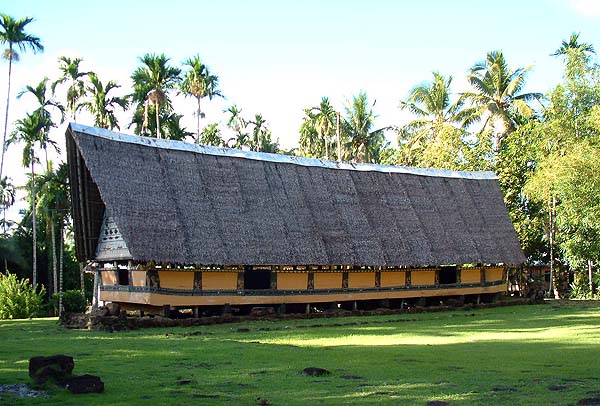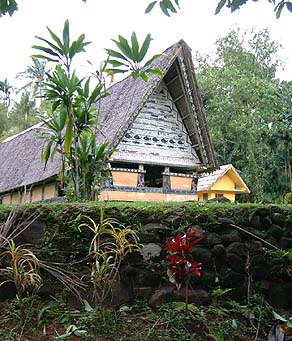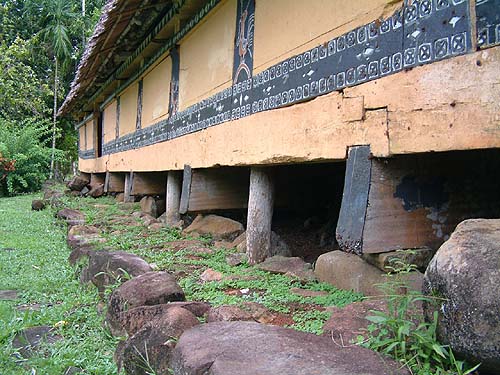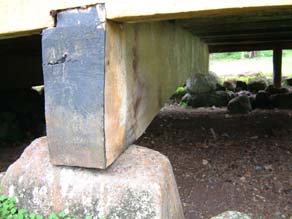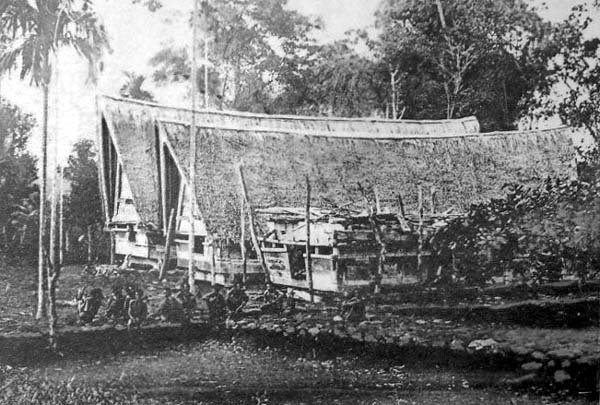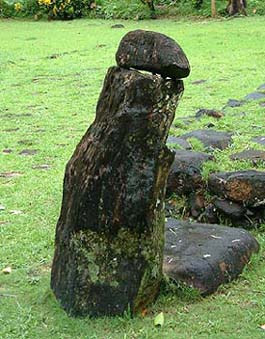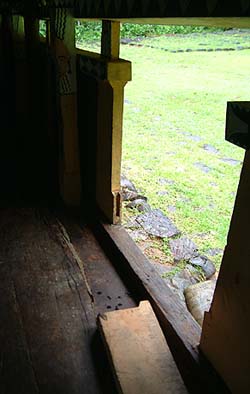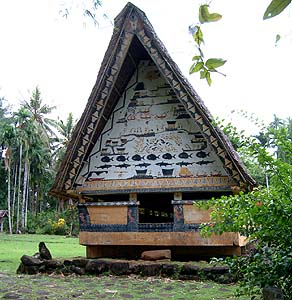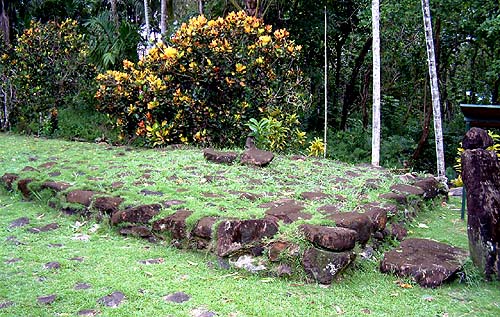 |
 |
 |
 |
||||
|
|
|
|
|
|
|
|
|
|
|
|||||||
|
|
|
|
The bai at Airai Village, or Bai-ra-Irrai. Two more bai once stood in the open area.
|
|
The chiefs of Airai Village tell us about the bai: “This bai is the house for the ten chiefs of this village. It is reserved exclusively for the council of chiefs of the village. This building is used exclusively for male chiefs, so women are not allowed here, unless we suspend the rules. It is basically the same building which has been occupied by our predecessors for the last 300 years. "In the traditional Palau, every village has one almost like this, but most of them have been destroyed, except for this one. Now we have the museum bai, which was built as a model, and we have a couple of recently built ones, one in Imeliik and one in Melekeok. But this is the original one."
|
||
|
|
||
|
"The structure is registered in the United States. It is one of the historical properties or buildings in Palau. Our number 2 chief was born and raised and holds a title in this village that you are visiting. His grandfather was born in 1850 and when he was born, this bai was standing. "It has been repaired and renovated about 10 times. But there are some original materials like the flooring, the foundation and the side, the corner. And every ten years we replace the roofing, that is made of woven nipa leaves."
|
|
|
|
"All the tie beams contain local legends, histories and mythology. All these beams contain local stories to remind us of our past. Both sides all have stories. So you cannot see what we can see from this side, so perhaps you go there and tell a story from that side. "The colors are taken from lime powder, you know the one that that you chew betelnut with, that is for the white one. That is for the white paint, we use that to make white paint. And the red, yellow are from some clays. And the black is from the ashes of the burned wood. So we have basically yellow, red, black and white colors. "
|
| |
|
“ We have certain symbols in the bai:”
|
|||
Other facets of the bai:
|
|||
|
|||
|
"This building is like a canoe sitting on top of logs. One chief here is a carpenter, and he says this bai is just sitting on top of the wood. There are no nails, so those joints hold it together. It is all tied together, everything, and so the weight will balance. It is just sitting, using its weight." "The bai is just standing on the beams," Walter adds. "This is a regular or medium-sized bai, with eight beams. We have some places where bai existed, and now there is only the stone beam platforms—we call them bad—where the beams rest. There are some village that have ten rows of those; those bai were much bigger. But this one is eight."
|
||
|
|
||
"And the master builder there said, when you build a bai you have to have the master builder," continue the chiefs. "And all the measurements are done by the out-stretching of the arm. Teréu is the length of both outstretched arms. Or you use the thumb and the finger, this is called meliútech. So it is all done by one guy, using strings, so it is symmetrical. "There are posts to support the bai. And they are made from a wood called dort, ironwood." See diagrams of the bai construction: angled view, and front view.
|
|
|
|
|
|
"A bai can be disassembled and put back together again, " Walter points out. "They took this one down during the war, and after the war, they hired the people from Ngerkedam, the villages from Ngerusar over to Ngetkib, on the west side of the Airai. They came and built and put it back again. And so we retained the measurements, some of the flooring, and the rest that needed to be replaced were replaced. But, the tradition has been carried on. "There were originally three bai here: Osebuulngau, then Ngerdubech el bai, and Outangelbai." Johnson adds, "One was a two-story, and one had only one post in the middle. Then every corner had its own smaller post. So when you walked it would tilt this way until the post hit the ground. It was intentionally done that way so that it would move like that."
|
|
|
|
Photograph from Kramer (1919) showing all three bai in Airai Village.
|
“Every village in Palau has a god" the chiefs continue. "This village has a god named Medechiibelau, who is suppose to sometimes appear in human form, sometimes not. And he is supposed to be in charge of this village. “Each village has about 10 clans. And a clan has about 2 or 4 lineages, and they have families, and each clan has a seat in the bai, and a title. These clans have names, and they have ranks: number one all the way to ten. And these clans all have roles. In Airai, number one position is occupied by Medechiibelau. His seat is given to the title bearer known as Ngerekiklang, named after Medechiibelau’s residence, Ngerekiklang. He is supposed to represent Medechiibelau."
|
||
|
|
||
| "Through him Medechiibelau joins us in our meetings, but he doesn’t talk much. His role is not so much to participate in discussion but to receive the share of Medechiibelau . If we have a feast, or we partake of any food provisions by the people, he eats the head of the pig, he gets the best food. "I am the number three chief. But customarily I’m like the number one. I am the head, because number one is Medechiibelau. But when we break the bai into two sections, on one side the odd numbers are aligned together—1, 3 ,5, 7, 9—and the other side is 2, 4, 6, 8, and 10. Then since Medechiibelau does not participate, the number 3 becomes number 1. But actually we still recognize Medechiibelau as the chief of Airai Village."
|
|
|
Side entrance.
|
“When the clans appoint a chief, the senior female members of the clan get together and select a male member to be the clan’s chief in the bai. And when he is appointed, the senior female members would bring him and present him to the council. The council can reject this appointment or accept him to be ‘their friend’. If he becomes ‘their friend,’ he would then hold a feast, serve food, and we eat to bring him in. “When he comes in, he will then tender a piece of money to the council as his 'bridge' into the bai and to buy his seat. Because when we are building the bai all the chiefs would actually buy their portion. And the higher you are, the more you have to pay. This distributes the cost among the members, based upon their ranks. That is why not anyone can sit here, because they didn’t pay for their portion."
|
"Each one of us has an assigned seat. I cannot sit anywhere. Normally my seat would be at that entrance over there, but when we have a conference meeting, we move this way and even we do move ourselves, we have assigned spots for us to sit. "When we have a meeting or conference, we don’t speak loudly. We use a go-between to carry our messages one to another. So it’s a kind of a' house of whispered conference meetings'. This way, if I make a mistake, I can always blame the messenger!"
|
|
|
|
|
|
"We reach decisions by consensus only. In the event we cannot reach a consensus, then the top four members of the council of chiefs, from the four corners, would step out to the stone platform outside which you saw when you came in, the little raised platform. The stone platform outside is called okeuídbad which means ‘70 stones.’ "And the four corner chiefs will go out there, exposing themselves to the elements until they reach consensus, whether it’s rain or shine or night or day, they have to be there. It forces them to agree."
|
||
|
|
||
|
Airai Village plays a larger role in bringing accord to Palau. Among the beams of the bai the story is told concerning the juncture of the pathways near the bai, a place in the village known today by the name Kombas.
|
||
|
|
||
|
|
|
|
|
|

|
| Airai Home | Map Library | Site Map | Pacific Worlds Home |
|
|
|
|

|
|
|
|||
| Copyright 2003 Pacific Worlds & Associates • Usage Policy • Webmaster |
|||
